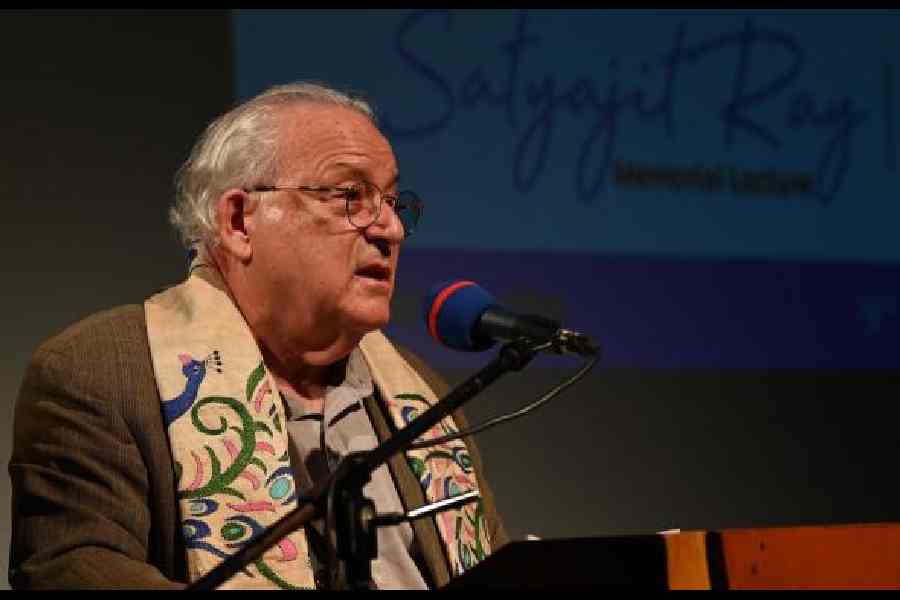The Satyajit Ray Memorial Lecture at the ongoing 29th Kolkata International Film Festival was delivered by Laurence Kardish at Sisir Mancha on December 9. Kardish, who worked as a film curator at the Museum of Modern Art for over 44 years and curated over 1,000 film exhibitions, was moved by Satyajit Ray’s Pather Panchali as a young movie enthusiast. Along with Ray, Kardish was equally enthused by Shirley Clarke, a major American filmmaker and video artist, and Shridhar Bapat, who worked with Shirley and is ‘a lesser known figure’. Exploring the intersection of these three figures along with his enthusiasm for Indian cinema was Kardish’s presentation titled ‘Satyajit, Shirley, Shridhar, and My Love Affair with Indian Cinema.’
After being introduced by director Arindam Sil, Kardish was felicitated by Aparna Sen. “I’m privileged to welcome Larry to Calcutta. He knew my father (Chidananda Dasgupta) well,” said Sen while felicitating him.
Starting the lecture with his perspective of Ray, Kardish said: “I think Ray was not only a filmmaker but he was the greatest artiste of the 20th century and he certainly influenced my life 8,000 miles away when I was growing up in North America.” Through his verbal presentation, Kardish informed the audience of how MoMA (Museum of Modern Art) opened as a film museum and Ernst Lubitsch came to America from Germany to establish the studio system and bring sound films making 1929 an unforgettable year in the history of the US. Sharing with the audience how Pather Panchali reached America before Cannes, he said: “Edward Harrisson distributed foreign language films for the American market and he immediately purchased the rights of the film of Apu and Durga and this was much before its premiere at the Cannes Film Festival. However, Edward Harrison couldn’t find a cinema in New York to show the film because some of the exhibitors said who wants to see a film about rural peasants. Even though it won an award at Cannes it was held up in New York until 1958 when two young exhibitors who found the criterion collection opened the film in Fifth Avenue Cinemas and it played for eight months. But we just found out that Ray was horrified because he had not seen the film before it was put on play and he wrote to Monroe Wheeler that the first half was full of blemishes and abrupt transitions from shot to shot, destroying the continuity of his film. Nevertheless, the film was a success and word began to spread about Pather Panchali.”
Speaking on the Ray retrospective exhibition, Kardish said: “Now we jump to 1980 and it was a project done by the Indo-US Subcommission on Education and Culture. Basically, it was a collaboration between Washington and Delhi to promote the culture of India and to sponsor a film exhibition called Film India, which was premiered at MoMA and travelled around the US. It was a three-part program — modern history of Indian cinema, a panorama of recent Indian films and most significantly, it would open with a retrospect of films of Satyajit Ray, who was described by the museum as an artist, author, musician and master filmmaker. Helping us in Calcutta with Ray’s films and with his advice on new Indian films was a marvellous Bengali film critic and historian Chidananda Dasgupta. And we included Ray’s most recent films — his short Piku.”
Kardish further informed how Ray found one of his lost films through this exhibition. “Ray also found his lost documentary, a film he made in 1971 for the king of Sikkim at the king’s request because the king felt the sovereignty of Sikkim was being threatened by both China and India. When India incorporated Sikkim, the film was banned and every copy of the film was destroyed. However, the Highness of Sikkim was an American who was back in New York in 1973 after the absorption of Sikkim in India and brought a copy of this documentary on Sikkim, which popped out of a washing machine in her New York apartment! We were able to show a complete retrospect and Ray was very pleased that we were able to find a print.” Kardish further mentioned how Kanchenjhunga, one of his favourite films, was also screened for a month.
Kardish in his lecture also recalled his visit to India in the 1980s with regard to the retrospect exhibition and being fascinated with the Mother India poster. So much so that he wished to see the film and was able to do so by purchasing tickets in black from his auto driver! “The theatre was packed and every song was being sung by the audience. It was a marvellous experience. I became more interested in knowing about Indian cinema,” said Kardish. His lecture further included his exploration of Shirley and Shridhar and he concluded saying, “I see Calcutta in relation to Mumbai as I see New York in relation to Los Angeles. Los Angeles is where entertainment is manufactured. Spiritual, intellectual and messy filmmaking I find in Calcutta. Calcutta is the far east you can get in India like New York is the far east you can get in the States.”











